What’s an Indalo? Why Indalo Man lucky symbol amulet souvenir means Good Luck in Spain
Why some people believe the Indalo could help them avoid bad luck
Avoid bad luck
Why is the lucky charm symbol Indalo used as an amulet or good luck charm – especially in Mojacar/Almeria/Andalucia Spain?
Please visit our CENTRAL shop for ALL our INDALO products (opens in a new window):
We have all touched wood to ward off misfortune . . or seen a bride throw a bouquet over her head at a wedding.
Where do such customs come from? Why do we use them?
The truth is that, behind many of our beliefs, there is a long history of superstition to which many people feel inwardly obliged to adhere. For example, the tradition of touching wood (or ‘knocking on wood’) dates back thousands of years. But even these days, there are few people who will openly tempt fate.
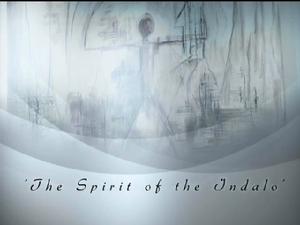
So many people avoid the number 13 that it is often absent from the floor of a hotel or the seat number on a plane. At some time in their lives, most people have had a good luck charm, amulet or talisman.
The Indalo is an acknowledged good luck symbol – especially in Almería, Spain. Many politicians, famous actors / actresses and sportsmen / sportswomen carry such a lucky charm or amulet, or have one in their house/car/office/bag. This is because they genuinely believe that the good luck charm will bring them good fortune and prosperity, and that it will make their day go just that little bit better than normal. And it has been proved that it is partly this BELIEF that makes them have more luck. The British museum has a whole collection of good luck charms dating back centuries; President Roosevelt carried one in his jacket, as did Napoleon.
It is often used to pass on good luck wishes to friends or colleagues . . or to say Take Care, Best Wishes, Congratulations or With Love.
The symbol of the Indalo Man is used extensively as a lucky charm, amulet or talisman all over the world and especially in the south east corner (Levante) of Spain. It is a well-known souvenir of the area of Almería, Andalucía.
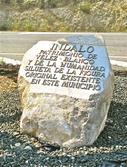 | 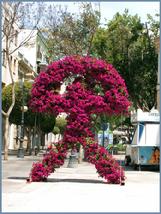 | 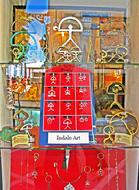 |
But why the Indalo or this Rainbow Man figure?
The ancient cave paintings of the Indalo . . .
. . were discovered in Almeria, south Spain in the late 19th Century, but they date back 4,500 years.
The paintings show figures of a man holding a rainbow in outstretched arms – not dissimilar to many such paintings found in various places around the world. Archaeologists and anthropologists believe they represent the search by primitive man for wisdom and truth in the universe. Others say the paintings are of men reaching up to the Holy Spirit and receiving the Lord’s grace. For the native Indian tribes of North America the rainbow was one of the most powerful qualities of the Great Spirit of creation and is often represented in sacred paintings and drawings by the Zuni, Hopi, and Navajo. Many environmentalists have adopted the symbol as a totem and the term Rainbow Warrior has been made famous by the campaigning ship owned by Greenpeace.
It is unclear whether the origin of the actual word Indalo, applied to Spain’s rainbow warrior figure, is San Indalecio – a 1st Century AD saint who was sent by Rome to evangalise the Iberian Peninsular (and who was martyred just outside Almeria city), or the phrase ‘Indal Eccius’ which means ‘Messenger of the Gods’ in old Iberian, or ‘In Deus’ which means ‘According to God’ in Latin. Either way, the little lucky charm is considered a guardian angel (a bit like a St. Christopher) . . not only being a symbol of good luck but also representing Man’s ethereal connection with the universe in which we live. It is a part of the culture of Spain and represents to some, the Mediterranean lifestyle typical in Almeria / Andalucia.
 |  | 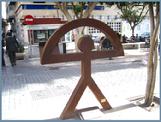 |
The rainbow is the bridge between the physical and the spiritual worlds, and in folklore, particularly in native North America, amongst the ancient tribes like the Cree, Sioux and the Hopi, legend foretells when the Great Spirit will once again rise up and the Rainbow Warrior will lead the world to freedom.
In Spain . . . the Indalo caves at Velez Blanco near Vera in Almeria, were declared a National Historical Monument in 1924 – and are now a site of UNESCO World Heritage. The Indalo is the symbol of the whole region of Almería and, in particular, a small village pueblo called Mojácar – because of its supposed flirtation many years ago with faith-healing, spells, and magic brews! Mojácar, in the southeast corner of Spain, with winding streets and with the warm waters of the Mediterranean lapping at its beach front resort, is now the adopted home of Indalo Man and you can see the lucky symbol wherever you go – like a little guardian angel representing to many, the local saint, Saint Indalecio whom some say originated the Indalo name. To anyone who visits (tourist OR Spanish), it is the only souvenir to take home – or to send to a friend.
 | 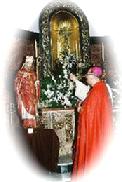 | 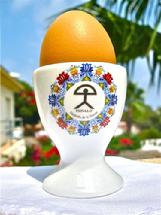 |
St. Indalecio, is venerated as the patron saint of Almería. In 1084, emissaries of Sancho Ramírez, King of Aragon and Navarre, moved the relics of “Indaletius” to San Juan de la Peña near Jaca in the north of the country, and some of these relics still rest in an urn under the main altar of the cathedral of Jaca. Thanks to the efforts of Bishop Rosendo some relics were returned to Almeria and placed under the altar of the Cathedral of the Incarnatio (as well as and at the Conciliar Seminary of San Indalecio de Almería). Saint Indalecio’s feast day is May 15, when a solemn procession moves through the city.
As lucky symbols and amulets go (and there are several), the Indalo really appeals. (It is reputed to be at its luckiest when given as a gift.)
“Luck affects everything”
Ovid
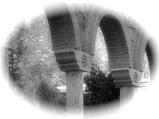 | 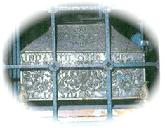 | 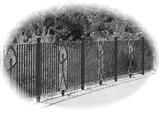 |

